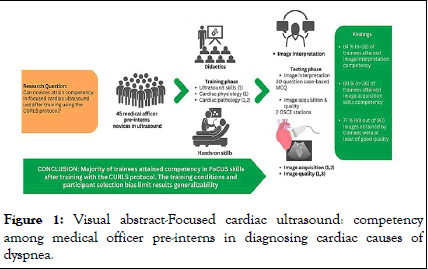Clinical & Experimental Cardiology
Open Access
ISSN: 2155-9880
ISSN: 2155-9880
Short Communication - (2025)Volume 16, Issue 7
In a quasi-experimental study conducted at the Kenyatta National Hospital in Nairobi, Kenya, 45 novice medical trainees were trained in limited cardiac ultrasound using the cardiac ultrasound for resource limited settings protocol. The training involved simulated didactic and hands-on sessions. It focused on image interpretation, acquisition and quality. Results showed that 84% of trainees achieved competency in image interpretation and were highly proficient in detecting specific conditions such as pericardial effusion and left atrial enlargement due to mitral valve disease. About 80% of trainees mastered image acquisition and three-quarters produced good quality images.
Cardiovascular disease in Kenya and sub-Saharan Africa is on the rise. Due to various factors, patients often present to hospital only when symptomatic, with advanced cardiac disease and with dyspnea being a common symptom. The diagnosis of cardiovascular causes of dyspnea relies on the availability of cardiovascular care experts and specialized tests and/or equipment such as cardiac biomarkers and echocardiography. Current evidence suggests that a restricted dataset of information obtained from cardiac ultrasound can be used by trained non-cardiologists to make critical care decisions in the acute setting of dyspnea of cardiovascular origin [1].
In resource limited settings such as Kenya, cardiovascular experts are scarce and specialized tests are unavailable in most tertiary facilities. However, ultrasound machines are widely available and so are junior medical staff such as medical officers. Training medical officers using simplified ultrasound protocols such as the non-validated Cardiac Ultrasound for Resource Limited settings (CURLS) can equip them with skills that may potentially alleviate this diagnostic challenge [2]. Simplified, context-specific, locally developed FoCUS protocols may also potentially bridge training gaps and enhance cardiac ultrasound use in sub-Saharan Africa.
The 2018 CURLs protocol is a non-validated limited cardiac ultrasound screening tool that utilizes sub-xiphoid views to diagnose gross cardiac abnormalities namely: Pericardial effusion, left atrial enlargement due to mitral valve disease, left ventricular enlargement due to cardiomyopathy, right ventricular enlargement due to pulmonary hypertension and left ventricular hypertrophy due to hypertension or aortic valve disease [3]. The protocol can be performed from ultrasound machines utilizing brightness and motion mode settings using the linear phased array or the convex probes. All these echocardiography diagnoses are prevalent in sub-Saharan Africa and easy to diagnose using limited cardiac ultrasound (Figure 1) [4].

Figure 1: Visual abstract-Focused cardiac ultrasound: competency among medical officer pre-interns in diagnosing cardiac causes of dyspnea.
Our findings are summarized as follows. Aggregate image interpretation competency was attained by n=38 (84%) of trainees with a median score of 80% [5]. The proportion of trainees attaining category-specific image interpretation competency was as follows: Pericardial effusion n=44 (98%), left atrial enlargement n=40 (89%), cardiomyopathy n=38 (84%), left ventricular hypertrophy n=37 (82%) and right ventricular enlargement n=29 (64%). Image acquisition skills competency was attained by n=36 (80%) of trainees. Three-quarters of trainee-obtained images were of good quality [6].
These findings suggest that novice medical trainees in resource limited settings can attain the requisite skills in FoCUS after a brief training. The training conditions and participant selection bias limit the generalizability of our results. Easy-to-train skills in FoCUS with a high diagnostic impact can be useful for junior medics practicing where experts and equipment are scarce.
These results build on the limited data available on the use of FoCUS training protocols developed in sub-Saharan Africa. A key limitation of the CURLs protocol is that a single window cardiac ultrasound view may not suffice for many patient presentations where cardiac pathology is subtle. We hope this work encourages the research and development of more robust FoCUS protocols that can enhance training initiatives and clinical use in resource limited settings such as ours.
[Crossref] [Google Scholar] [PubMed]
[Crossref] [Google Scholar] [PubMed]
[Crossref] [Google Scholar] [PubMed]
[Crossref] [Google Scholar] [PubMed]
Citation: Muriuki DM (2025) FoCUS Training among Pre-Internship Medical Officers in Diagnosing Cardiac Causes of Dyspnea. J Clin Exp Cardiolog. 16:960.
Received: 02-May-2024, Manuscript No. JCEC-24-31054; Editor assigned: 07-May-2024, Pre QC No. JCEC-24-31054 (PQ); Reviewed: 21-May-2024, QC No. JCEC-24-31054; Revised: 09-Jul-2025, Manuscript No. JCEC-24-31054 (R); Published: 16-Jul-2025 , DOI: 10.35248/2155-9880.25.16.960
Copyright: © 2025 Muriuki DM. This is an open-access article distributed under the terms of the Creative Commons Attribution License, which permits unrestricted use, distribution, and reproduction in any medium, provided the original author and source are credited.